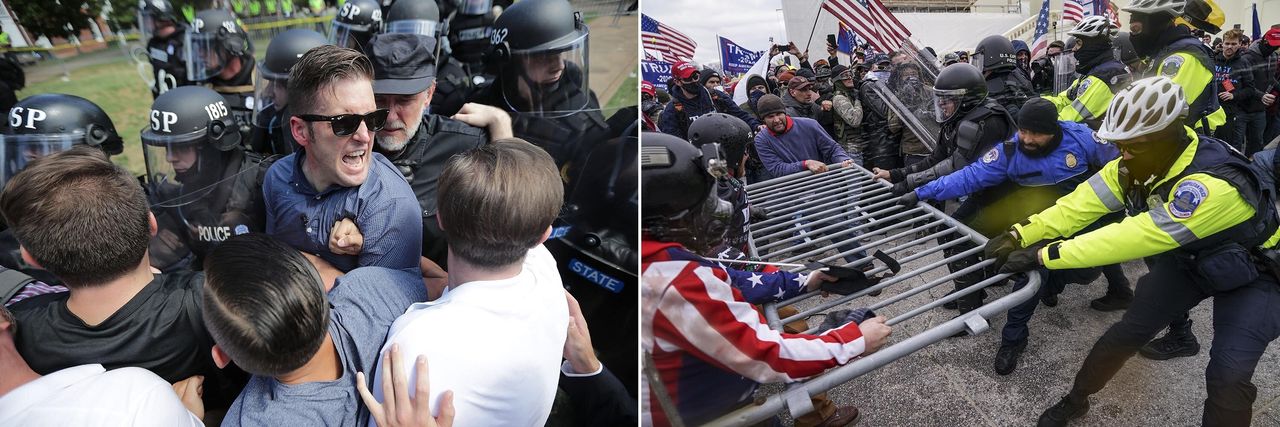For years, Black activists in Charlottesville, Virginia, say they have felt like Cassandra, the Trojan princess gifted with the ability to see the future, but cursed to have no one believe her.
The activists foresaw, in the wake of the deadly 2017 white supremacist rally in their city, a resurgent fascist movement in this country that would gain in strength and power, and commit even more horrific acts of violence. But as they raised alarm about this growing danger — arguing for the need to confront fascists in the streets and to deplatform them online — the activists said they were often dismissed as alarmist, hysterical or too extreme.
Last week, while the world watched in horror as a mob of MAGA insurrectionists breached the U.S. Capitol, many in this group of activists started sharing a meme online.
“Dear America,” it said, “We tried to tell you. Sincerely, Charlottesville.”
Lisa Woolfork, an anti-racist organizer in Charlottesville, recognized some of the MAGA rioters in the Capitol as she watched the chaos unfold on TV and on social media.
“Those were the same people who were in our streets, who tried to murder all of us and succeeded in only murdering one person and injuring dozens,” she told HuffPost. “It is a reminder of that. Charlottesville is really in a position of ‘I told you so’ right now.”
“What might surprise some people — didn’t surprise me — was that it could happen at the nation’s Capitol,” Woolfork added. “That’s not a surprise at all. That’s chickens coming home to roost. Why wouldn’t they go there? That’s where their instructions came from.”
On Aug. 11, 2017, neo-Nazis and white supremacists held a tiki-torch-lit march through Charlottesville, chanting “You will not replace us” and “Jews will not replace us.” They attacked anti-racist activists with their torches and called in threats to churches and synagogues.

The next day, on Aug. 12, they gathered near a monument of Confederate General Robert E. Lee for a “Unite The Right” rally, the largest white supremacist gathering in over a generation. They chanted “Fuck you faggots” at counterprotesters, whom they attacked repeatedly as police stood idly by, watching. They beat a young Black man named Deandre Harris with a flagpole in a parking garage. Eventually a neo-Nazi drove his car into a crowd of counterprotesters, sending bodies flying into the air, killing 32-year-old Heather Heyer and injuring many more.
Ever since, the name “Charlottesville” has been synonymous in America with white supremacist terror — an unfortunate shorthand for describing an ascendant alt-right emboldened by the election victory of President Donald Trump, a racist with clear authoritarian inclinations.
Yet after the Charlottesville rally, the very activists who bravely confronted the alt-right in the streets — who saw its ugliness and evil up close, who understood better than most the specific threat it posed — often found themselves ignored, or even demonized.
A 2017 study by Fairness and Accuracy In Reporting found that the country’s six biggest newspapers, in the months after the “Unite The Right” rally, spilled the same amount of ink in their op-ed pages condemning anti-fascists as they did fascists.
Zyahna Bryant, a 20-year-old activist in Charlottesville, remembers those types of condemnations.
There was a prevailing narrative that “we should ignore white supremacists” when they come to town, Byant recalled in a video she posted to Instagram last week after the siege at the Capitol. “‘We shouldn’t fuel the fire,’” she recalled people saying. “‘We should just ignore them. They’ll go home eventually.’”
“And now here we are, three-plus years later, and still dealing with the racial trauma and the aftermath of the 2017 attacks in Charlottesville, and we’re seeing these white supremacist groups are multiplying,” Bryant said.
Going forward, Bryant emphasized, “It’s really important to honestly and truly listen to Black people. Black folks like myself from Charlottesville have been telling y’all that this would continue to take place.”
Jalane Schmidt, a Charlottesville-based anti-racist organizer who teaches religious studies at the University of Virginia, also remembers her warnings often going unacknowledged.
“We got dismissed. You get dismissed if you use the ‘F word,’” Schmidt told HuffPost of using the term “fascism” to describe the president and the MAGA movement he created.
“We were early calling this out,” Schmidt continued, “saying, ‘This guy is a demagogue, he wants to be dictator,’ showing that he was a fascist, but you use that word and you just get dismissed out of hand, because ... a lot of people don’t have the mental apparatus, it’s not within their frame of reference to think about this happening here. Like, they think it can’t happen here.”
Watching the siege at the Capitol last week, Schmidt said one of the biggest parallels she observed with her experience in Charlottesville was how police hadn’t seen the MAGA rioters and white supremacists as a potential threat.
“They see them as annoying,” Schmidt said. “They see them as something obnoxious, you know, loud and uncouth sometimes, you know, but they don’t see them as a threat, as like a blood-on-the-street, bones-pressing-through-flesh, people-dying kind of threat.”
Multiple reports over the last week have documented the ways in which the U.S. Capitol Police were severely understaffed ahead of Jan. 6, and ignored massive amounts of intelligence showing the planned MAGA protest against the results of the 2020 presidential election would turn into an attempted insurrection.
Unlike many police departments, Schmidt told HuffPost, people of color in America have an intrinsic understanding of “white people making good on their threats.”
It was infuriating then, she said, to hear Acting Metropolitan Police Department Chief Robert Contee claim after the siege at the Capitol that police had no indication there would be a breach.
“I was sitting 200 miles away in Charlottesville, Virginia,” Schmidt recalled thinking, “and I knew it was gonna be violent!”
Elise Foley contributed reporting.
